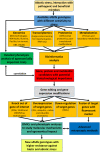Biotechnological Perspectives of Omics and Genetic Engineering Methods in Alfalfa
- PMID: 32508859
- PMCID: PMC7253590
- DOI: 10.3389/fpls.2020.00592
Biotechnological Perspectives of Omics and Genetic Engineering Methods in Alfalfa
Abstract
For several decades, researchers are working to develop improved major crops with better adaptability and tolerance to environmental stresses. Forage legumes have been widely spread in the world due to their great ecological and economic values. Abiotic and biotic stresses are main factors limiting legume production, however, alfalfa (Medicago sativa L.) shows relatively high level of tolerance to drought and salt stress. Efforts focused on alfalfa improvements have led to the release of cultivars with new traits of agronomic importance such as high yield, better stress tolerance or forage quality. Alfalfa has very high nutritional value due to its efficient symbiotic association with nitrogen-fixing bacteria, while deep root system can help to prevent soil water loss in dry lands. The use of modern biotechnology tools is challenging in alfalfa since full genome, unlike to its close relative barrel medic (Medicago truncatula Gaertn.), was not released yet. Identification, isolation, and improvement of genes involved in abiotic or biotic stress response significantly contributed to the progress of our understanding how crop plants cope with these environmental challenges. In this review, we provide an overview of the progress that has been made in high-throughput sequencing, characterization of genes for abiotic or biotic stress tolerance, gene editing, as well as proteomic and metabolomics techniques bearing biotechnological potential for alfalfa improvement.
Keywords: Medicago sativa; alfalfa; genomics; metabolomics; proteomics; stress resistance genes.
Copyright © 2020 Hrbáčková, Dvořák, Takáč, Tichá, Luptovčiak, Šamajová, Ovečka and Šamaj.
Figures
References
-
- Abdelrahman M., El-Sayed M., Sato S., Hirakawa H., Ito S. I., Tanaka K., et al. (2017a). RNA-sequencing-based transcriptome and biochemical analyses of steroidal saponin pathway in a complete set of Allium fistulosum-A. cepa monosomic addition lines. PLoS One 12:e0181784 10.1371/journal.pone.0181784 - DOI - PMC - PubMed
-
- Abdelrahman M., Sawada Y., Nakabayashi R., Sato S., Hirakawa H., El-Sayed M., et al. (2015). Integrating transcriptome and target metabolome variability in doubled haploids of Allium cepa for abiotic stress protection. Mol. Breed. 35:195 10.1007/s11032-015-0378-2 - DOI
Publication types
LinkOut - more resources
Full Text Sources


